Ideally, children will get all of the information they need at home from their parents, but school should also be an important source of information.
Here is why:
Every time we had a sex talk back in high school, the coordinator would have a box where we would drop pieces of papers anonymously with questions to be answered at the end of the forum. Most of the questions that were asked are:
I know you might be thinking, these are just basic straight forward questions. Now that I am all grown up, I think these questions were real concerns for us because we had never been taught about sex.
The only basic thing was, “Do not have sex until you are married!” and “If you have sex you will get pregnant and your parents will be pissed!”
Lack of sex education- both by parents and in schools- is a major crisis that has major ripple effects through many parts of society.
Lack of sex education in schools has been identified as a major contributory factor to the high rate of teenage pregnancy and unsafe abortion in the country.
Believe it or not, every girl or boy ill one day has to make a life-changing decision about their sexual and reproductive health.
So imagine the gap that exists in the lack of knowledge that these young people require to make these kinds of decisions responsibly. This is why most of our young people are vulnerable to early pregnancies, coercion, and STI’s.
This is what we recommend. A Comprehensive Sexuality Education.
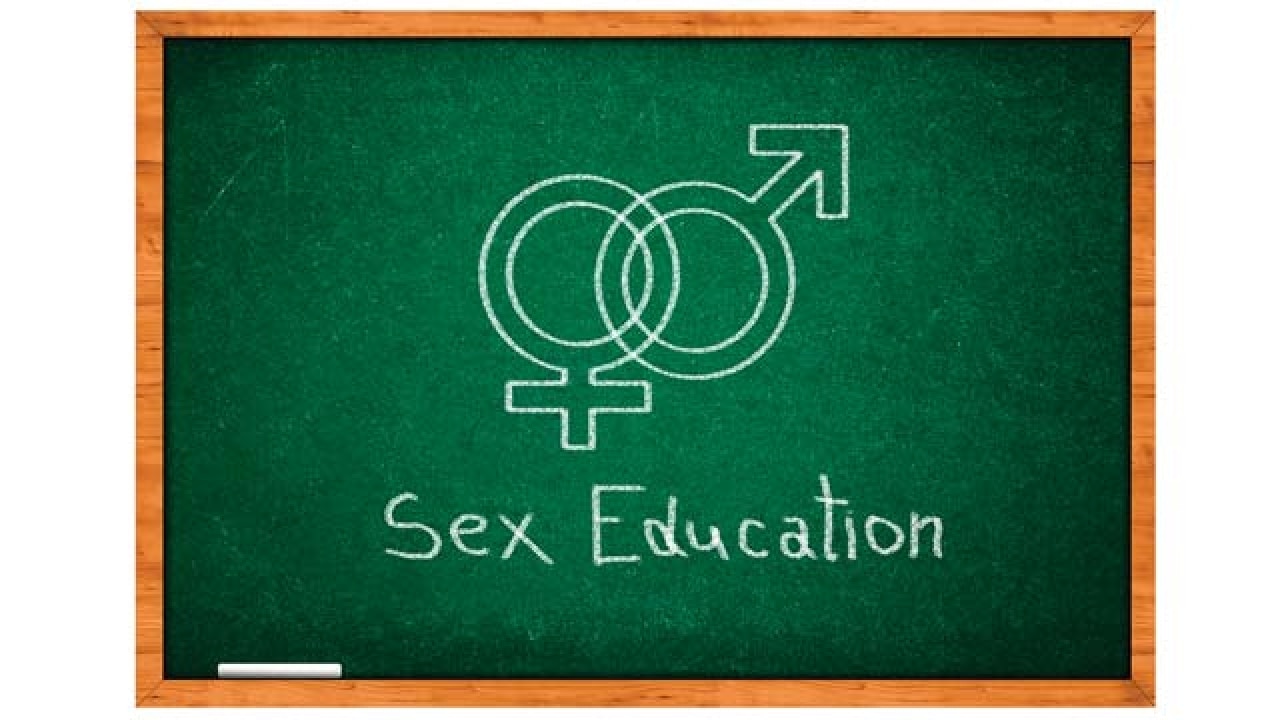
Comprehensive sexuality education is based on an approach that focusses on gender and rights.
Whether in school or at home, this kind of sex education is taught throughout the adolescent life, to every age group depending on information relevant to their ages.
There are various things you can cover.
First are facts about human anatomy, reproductive health, and human development. You can go deeper on topics like contraception, consent, sexually transmitted infections, HIV, and childbirth.
Apart from pumping the youth with information, it is good to nurture positive values regarding their sexual and reproductive health. Such values are based on relationships, culture, gender roles, sexual abuse, and human rights. It is what I refer to as holistic sexuality education.
With these kind of knowledge, our young people will develop skills like critical thinking, communication, responsible decision making, and self-esteem.
Talking to children about sex is not an easy task.
If you are keen on the news an social media, there have been so many cases of early pregnancies, sexual assault cases, kidnappings, deaths, and sexually transmitted diseases.
This means that the one talk you gave your children about the birds and the bees is not enough. You should have an ongoing talk frequently according to the age they are in.
Ideally, children will get all of the information they need at home from their parents, but school should also be an important source of information.
Here is why:
There has been a huge debate in the past about providing condoms in school and teaching contraception to teenagers.
It has been said that giving these options will make them promiscuous.
To be honest, teaching comprehensive sex education doesn’t have the downside most people are afraid of.
Providing these options does not encourage adolescents to start having sex earlier, it only helps them be safe in case they choose to have sex.
In this generation, they are already having sex at a very early age so it is good that they have safe sex.
There have been so many efforts to curb teenage pregnancies but you have seen how the numbers have risen recently especially during the COVID-19 pandemic.
Poverty is one of the primary causes of teenage pregnancies but so is a lack of sex education.
Immediately your child starts becoming eager and curious about their body, you should start educating them right there and continue throughout each stage of their lives.
Abstaining from sex before marriage is a tradition that the current generation does not hold in high regard.
As a parent, you have to accept this hard truth and talk to your children about protecting themselves, making informed decisions, and keeping healthier sexualities.
If you feel like “No! my child will abstain from sex”, which is admirable, you are still not exempted from teaching them about sex.
They too need sex education. If a child grows being well informed, he or she will be empowered by that information and will respect people’s opinions and sexualities.
Furthermore, your child will not source information from their peers or the internet. We all know these sources are not reliable because of misinformation.
Do you know why you hear teenagers having oral sex and anal sex instead of vaginal sex?
It is because they do not have accurate information about alternative sexual behaviors.
Young people think that oral sex is incompatible with abstinence because abstinence involves vaginal intercourse so they believe.
With a comprehensive sex education approach, teenagers will be more informed about participating in alternative sexual behaviors instead of falsely assuming these alternatives are safe.
If we do not teach sex education, we will have generations that are completely unequipped to advocate for their bodily autonomy and are extremely ashamed about any sexuality that they’ve experienced.
We will fail generations of women when we set them up to be hurt, and we failed those generations of men when we fed them toxic masculinity instead of teaching them about consent and pleasure for all bodies.
If we’re to move forward, we need to find a way to build systems that educate and protect. What Do you think?
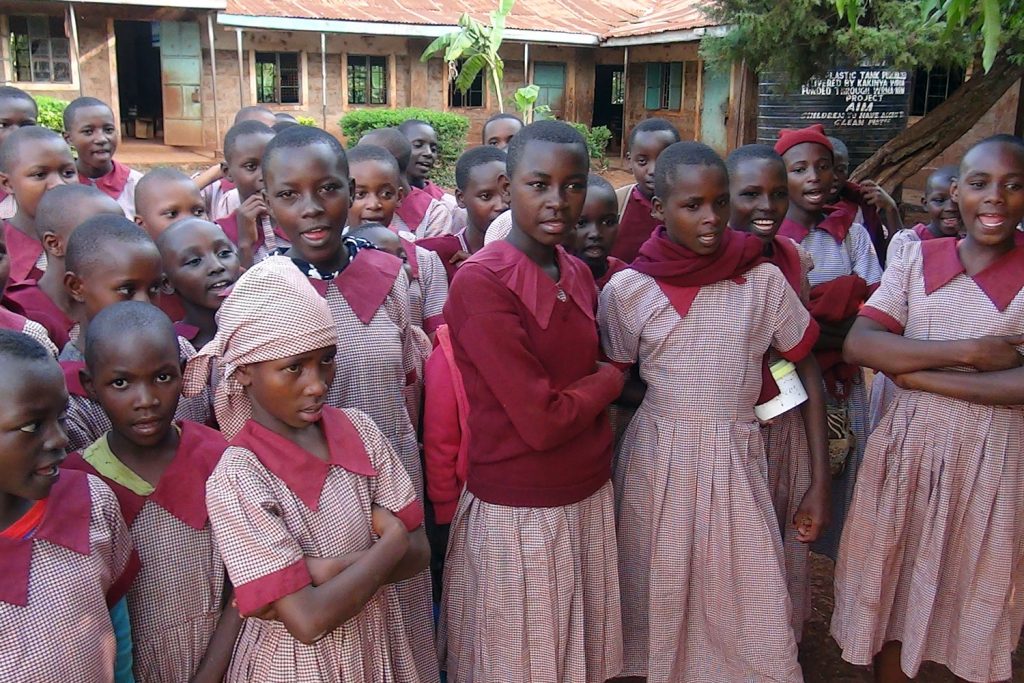
743 million!! That’s the number of girls that are out of school right now due to schools shutting down to prevent the spread of coronavirus.
Most of these girls may never even return to school after the crisis is over.
Do you know what this means?
These girls are going to miss out on so many opportunities. They are also more likely to experience abuse, child marriage, early pregnancies, violence, and hardship.
With so many issues arising during this time like police brutality, gender-based violence, and digital gaps, we also need to take a close look at how the COVID-19 pandemic will impact girls around the world, and examine past crises to understand the current risks.
Over the past few months, as COVID-19 has moved from a fear-producing unknown to an era-defining terror, we’ve seen mainstream media coverage that mirrors the failures of our healthcare system, the police force, and the government as a whole.
Teenage pregnancies are rising in the wake of this pandemic because so many girls are being sexually exploited in the crisis-affected areas.
Susan, a 15-year-old girl says “ I know that so many girls in my area will suffer. There will be a scarcity of food, we will get abused and violated. Boys always ask for sexual favors if we ask them for help.”
Low-income families are most likely to force their daughters into early marriage. These girls will no longer be able to go back to school and live up to their full potential.
Related Stories: Poverty and Depression as a Result of COVID-19 Has Affected the Youth in Kenya.

Pandemics have been seen to make existing gender inequalities worse and can make it more difficult for women and girls to receive treatment and health.
Health care systems have been forced to channel all of their resources to combat an epidemic so sexual and reproductive health care has been overlooked despite the persistent need for adequate family planning, menstrual health resources, and maternal care.
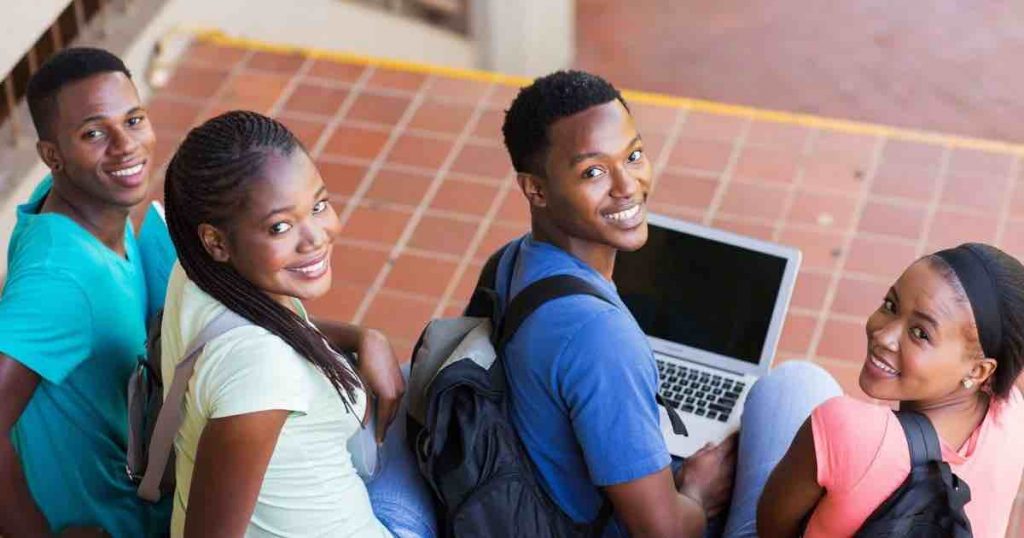
Many schools all over the world have turned to remote learning to keep students busy but it is unfortunate that most girls do not have access to the tools that are required.
Did you know that only 39% of girls who live in rural areas make it to secondary school? Boys, on the other hand, 45% of them make it to secondary school globally.
Now imagine how much this divide has grown due to COVID-19.
Families choosing boys to go to school over girls is as a result of gender norms. It is absurd how in the 21st century, there is no agency in such issues. Girls still do not have a voice.
Related Stories: Coronavirus- How to Manage Your Mental Health During Self-Isolation.

Another issue is that the number of boys in low-income families who own smartphones is much higher compared to girls.
Remote learning becomes so much easier for them. Girls not only do not have access to remote learning, but also general access to learning period!
The big challenge that has remained in many countries is that girls drop out of school at much higher rates than boys.
We have made so much effort to get girls to go to school, and suddenly schools are closed.
School closures are not only causing girls to miss out academically; they also prevent girls from having access to benefits like support from other students and teachers, or the chance to network.
Protect A Girls Image is calling on governments and local authorities to make education affordable and accessible for all, continue access to sexual and reproductive information and services, protect families from hunger, tackle gender-based violence, and provide support for refugees, girls, and women.
Truth is that in times of crisis, disparities like these become even more apparent.
We have seen the effects this pandemic is having on women and girls.
From the increased reports of domestic violence as survivors are forced to lockdown with their abusers, to the restrictions on reproductive healthcare and the challenges of working women struggling to balance work and family.
The fact that 85% of all nurses, 75% of primary caregivers, and 62% of minimum and low-wage workers are women—women and girls’ lives are especially impacted by this pandemic.
There is a need to look at the global crisis through a gendered lens, to create awareness so we can then address these issues and create change.
Do you agree?
Covid-19, the disease caused by the coronavirus, has adversely affected the mental and socioeconomic well-being of young Kenyans, a new survey reports.
The study, which was conducted by AMREF Health Africa between April 30 and May 5 across all the 47 counties, in alliance with the Ministry of Health, Population Council and Youth in Action, indicates that the effects of Covid-19, such as loss of jobs, have heightened stress levels among young people, worsening their mental and health well-being.
“Covid-19 is having significant negative effects on the mental health, economic and social status of the youth: nearly a third (27 percent) are experiencing more stress and 30 percent have reported living in fear,” the report notes.
SEE ALSO: The Corona Hairstyle Is Spreading An Important Message About Covid-19 In Kenya
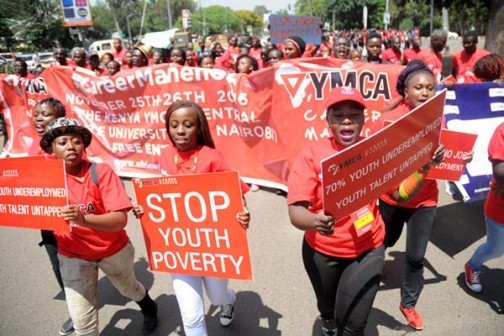
The main source of worry and stress for young people is the reduction of income and complete loss of jobs amidst rising expenses, the report says.
This is as 50 percent of young Kenyans have suffered from a significantly reduced income whereas 22.9 percent of the Kenyan youth have lost their source of livelihood due to the virus epidemic.
The report also added, “34 percent of young Kenyans experienced increases expenses in the house and 33 percent experienced an increase in food prices, with more females than males experiencing an increase in household expenses (36.7 percent vs 31.9 percent) and increase in food prices (34.5 percent vs 32.6 percent”.
According to the findings of the report, the group also recorded an increase in violence at home. 1.7 percent of the respondents revealed that they have been victims of violence at home during the pandemic period.
The changes in normal roles and routines create stress for family members, including children who cannot attend school and may not know why they cannot.
Additionally, parents must struggle to strike a balance between explaining the pandemic to their children without heightening their fear.
For parents who also double up as health care workers, the conflict between being professionals and infecting their families become real.
These conflicts are likely to cause feelings of guilt, fear, and anxiety, among others.
Lastly, as home environments become toxic due to depressed affect, school closures, and diminishing resources among others, the odds of family violence increase.
SEE ALSO: Fighting Against Gender-Based Violence During The Covid-19 Pandemic in Kenya
Fear, worry, and stress are normal responses to perceived or real threats, and at times when we are faced with uncertainty or the unknown.
So it is normal and understandable that youth in Kenya are experiencing fear in the context of the COVID-19 pandemic.
Added to the fear of contracting the virus in a pandemic such as COVID-19 are the significant changes to our daily lives as our movements are restricted in support of efforts to contain and slow down the spread of the virus.
Most are struggling with anxiety and depression because they are faced with new realities of working from home, temporary unemployment, home-schooling of children, and lack of physical contact with other family members, friends, and colleagues.
At least six people died from police violence during the first 10 days of Kenya’s dusk-to-dawn curfew, imposed on March 27, 2020, to contain the spread of Covid-19. As of today, the number has shot up to 12 which includes children.
The police, without apparent justification, shot and beat people at markets or returning home from work, even before the daily start of the curfew.
Police have also broken into homes and shops, extorted money from residents, or looted food in locations across the country.
It is shocking that people are losing their lives and livelihoods while supposedly being protected from infection.
Police brutality isn’t just unlawful; it is also counterproductive in fighting the spread of the virus.
SEE ALSO: Tips For Parents During The Coronavirus Outbreak – Infographics
Five percent of women cannot access emergency pills or sanitary towels due to the movement restrictions, while eight percent of men reported a lack of access to condoms.
Youth with HIV have also been affected adversely, with 2.3 percent saying that Covid-19 has cut off their access to ARV medication and 4.7 percent noting that they are unable to access HIV/AIDS counseling.
Additionally, nearly half of the young people surveyed indicated that they would not be able to self-isolate if infected with Covid-19 due to reduced income or loss of jobs, which makes them unable to afford isolation.
Diseases will not also wait for coronavirus to be over!!
SEE ALSO: How To Manage Your Mental Health During Self Isolation
Regardless of these effects, the report shows that an overwhelming majority of young Kenyans are taking the necessary precautions.
They are adopting positive behavior to avoid infection with Covid-19, practicing hand hygiene, and wearing personal protective equipment since they started to receive messages on Covid-19.
For instance, 99 percent of young people are avoiding travel, 98 percent are using masks in public, 98 percent are washing hands, and 20 percent using hand sanitizers.
Little is known about the experiences of our people under public health protocols in terms of compliance, difficulties, and psychological impact.
The resulting interruption of filial and other bonds due to fears about infecting self and others, and/or avoidance behaviors during and post-isolation are issues of concern to social scientists.
Further, public health protocols that directly contradict long-held traditions, for instance, concerning how and when burials are to be conducted has ramifications for their success.
Finally, fear of social stigma for those infected may cause people to deny early symptoms and consequently fail at early diagnosis.
It is important to note that early diagnosis is essential for the management of a new disease as COVID-19.
Therefore, it is important to understand how people perceive interventions and what psychological mechanisms are triggered by coercive measures.
As Kenya began closing schools and colleges on 15th March 2020 and shifting to online education to limit the novel coronavirus, 36-year-old Teresa Waruguru worried about how she, her two children, and her neighbor’s son would be able to get by with one computer.
Teresa, who is a freelancer, needs it during the day and the 3 children also need it for an online learning program given by their schools.
It’s a problem unfolding across the country.
Many students lack computers or high-speed internet at home, and schools can’t provide the same online education to every student when some can’t log on at all.
This is especially the case for children in rural, marginalized communities like the Maasai, Samburu, Turkana, Pokot, Marakwet, and Sabaot, and in coastal regions; refugee children in Kakuma and Dadaab refugee camps; and children with disabilities.
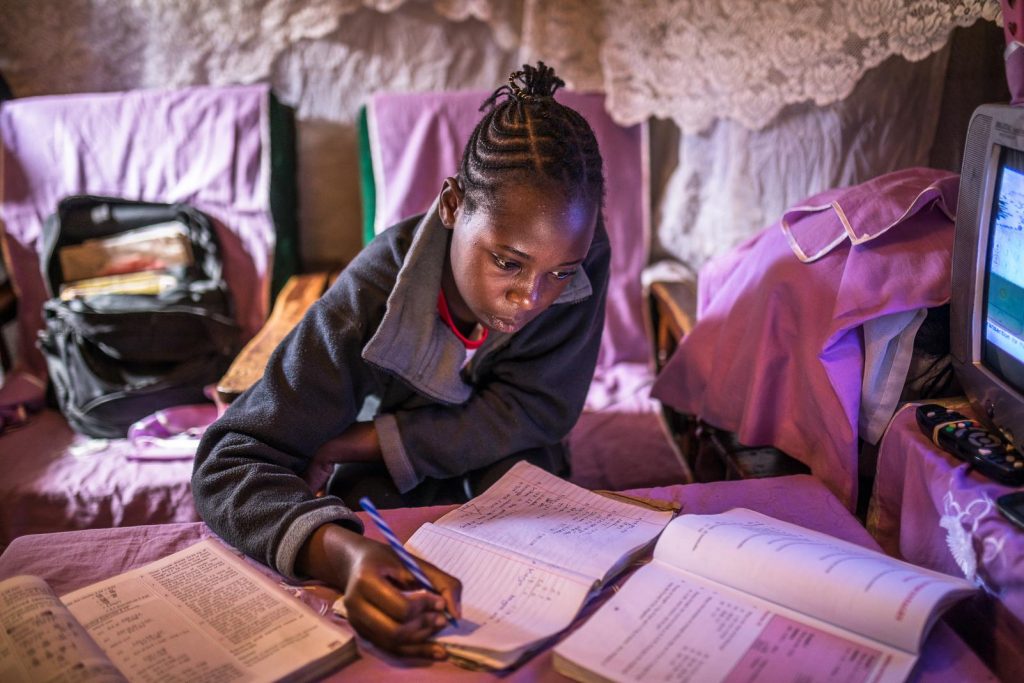
Since schools closed in Kenya, the ministry of education and other agencies have indicated that learners should undertake online learning or technology-mediated learning on TV, radio, ed-tech apps, and mobile phones.
While such learning may take place in urban areas, for many marginalized children in remote villages—including refugee children in camps as well as those living with various disabilities—learning during COVID-19 school closures is a deep challenge.
Learning mediated through ed-tech remains out of reach for many disadvantaged children due to connectivity challenges.
In remote parts of Kajiado, Narok, Samburu, Turkana, and Kilifi counties, for example, electricity does not reach households, excluding children from online learning.
Additionally, smartphones are beyond the reach of most rural communities.
Even when adults have smartphones, tensions around privacy and kids’ unsupervised internet use render access for learning nonexistent.
And where electricity and technology do exist, the cost of the internet is prohibitive.
Such disadvantages present challenges for rural families and learners who must compete with their more privileged peers during national examinations.
The quarantines and curfews imposed by governments as a response to the COVID-19 pandemic also lead to learning loss.
If children experience learning loss during normal extended school holidays, it remains to be determined how much learning will be lost during extended emergency closures.
For rural children of parents with low literacy levels and limited education resources, this risk of learning loss is heightened.
Not only are these parents frustrated at having to homeschool without adequate preparation, but they also cannot reinforce their children’s learning.
Intermittent online learning is not effective for students already behind, and radio learning cannot replace classroom learning as it is intended to supplement the knowledge that children already have.
School closures also have implications for learners who rely on school feeding programs as a main source of nutrition.
With everyone now at home, families’ ability to provide food for their children has been even further reduced.
In such poverty, securing food takes precedence over learning.
For instance, the closure of schools in Kenya has also coincided with the planting seasons where poor families are likely to take advantage of labor provided by children at home.
This is especially the case for girls and young women whose duties include working on farms, household chores, and caring for family members.
Anecdotal evidence suggests that rural girls are likely to be used to cushion families’ income, which further exposes girls to sexual exploitation and gender-based violence.
This places girls at especially high risk of health and reproductive crises, including forced female genital mutilation, as well as early marriage, which puts girls at high risk of dropping out when schools reopen.
Decreased mobility from quarantines and curfews also restricts girls and women from essential protection services and support networks, further diminishing their autonomy.

Universities have been forced to turn to online learning to ensure students finish their courses on time, but preparedness varies from one institution to the next.
Dr. Richard Bosire, the chairman of the Universities Academic Staff Union’s University of Nairobi chapter, was quoted in local media as saying: “Not all lecturers had been trained and those who had were waiting for directions on how to proceed.
Most students do not have laptops or money to buy internet bundles to sustain a three-hour online course.
Some of them live in far-flung areas and do not even have access to the internet, so how will they be expected to come on board?”
“At Kenyan universities, online learning is mainly focused on postgraduate students with the larger population, undergraduate learners, left out. Part of the problem is lack of investment in online resources by the institutions,” said the local Daily Nation newspaper in an editorial on 28 March.
“The obvious drawback for e-learning is the digital divide. Most families have limited or no access to the internet. Such a situation does not belong to the future but the present,” the newspaper said.
In Kenya, successful electronic-based degree programs have been dominated by foreign and international qualifications, mostly postgraduate degrees featuring collaborations between local private institutions and foreign institutions.
The statement follows resistance from a section of students from the University of Nairobi (UON), some of whom were active in a trending discussion on Twitter on 30 March (#UONboycottonlineclasses) during which they resisted the announcement by the university that lessons would continue online.
“You want me to take online classes. I live in Turkana (in far-off remote northern Kenya). Does this university even care that I obviously can’t access [the] internet? It is the University of Nairobi, not University for people of Nairobi,” tweeted student Jared Washington Ochako.
“Training is an inevitable part of any business but depending solely on an e-learning platform can make learning less personal, less engaging, and in the process, less effective. We urge comrades to boycott such shenanigans by UON,” said another student going by the online name Mzee Mzima.
Students argued that online learning could not be inclusive given the circumstances and would exclude those disadvantaged by poor infrastructure.
Conclusion
To support children across Kenya in continuing their education, UNICEF has been working with the government to provide radio, TV, and Internet lessons.
Despite the challenges in marginalized communities, many children are using these resources to continue learning.
The Kenya Institute of Curriculum Development (KICD) estimates that 47% of learners are accessing lessons through radio, TV, or the Internet.
This means that over half of Kenya students are not able to access remote lessons, either because they are outside of the broadcast range or do not have the necessary equipment.
To address this, UNICEF is mapping areas without radio and exploring ways to reach children, including by distributing 27,500 solar-powered radios for learners without access to lessons.
They are also distributing textbooks to 18,350 students in refugee camps and have provided academic and physical fitness tutorials through smartphones to children in informal settlements, including those with disabilities.
Who could have imagined that a Simple Hairstyle would become a conversation starter and fundraising tool for COVID-19?
Necessity is the mother of invention!
These women in Kibera Slum, an Informal settlement in Nairobi, Kenya are using a hairstyle to raise Awareness about Coronavirus.
Its called the “Coronavirus Hairstyle”.
The “corona hairstyle” is shaped just like the virus: it has long spikes and a small circular crown.
Other hairstylists hope it will bring much-needed community awareness about the pandemic in this area.
Some salons in Kibera Slum charge 1 dollar to make a hairstyle very popular amongst children in Kibera.
This in turn sends a message of awareness about the new virus.

Jane Mbone, 7, arrives home after having her hair styled in the shape of the new coronavirus at the Mama Brayo Beauty Salon in the Kibera slum.
A hairstyle that has popularly been around Africa for many years has become much more than a look in Nairobi, Kenya.
Kenya currently has 715 cases of COVID-19 and has put measures into effect to combat the pandemic, such as implementing curfews and releasing of prisoners.
Hairstyles have historically carried meaning in Africa, from revealing a wearer’s relationship status to their family’s social standing.
Variations of the “corona hairstyle” have been plaited from generation to generation.
Sharon Refa, a hairstylist in the slum feels that there still needs to be aware of how to protect oneself and others from coronavirus.
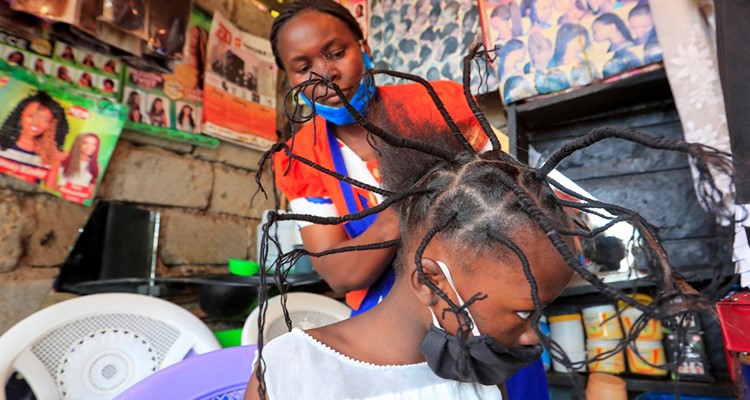
“Many Slumdwellers don’t believe that the coronavirus is real,” Refa said.
The World Health Organisation (WHO) recommends regularly washing hands with water and soap or cleaning them with a sanitizer.
They also recommend wearing masks and social distancing when in public.
But another challenge Kenya faces in its fight against COVID-19 is lack of clean water and sanitation.
According to Water.org, a digital platform that advocates for access to water and sanitation, 41% of Kenyans get their water supply from ponds, shallow wells, and rivers, while 71% of the population lack access to sanitation. The challenges are even more pronounced in slums like Kibera.
Refa added that many adults in her community are reluctant to wear masks or use hand sanitizer, which is why she and her colleagues came up with the “corona hairstyle,”. The hairstyle also helps in communicating with the public about the virus.
The corona hairstyle is a way to be stylish on a seriously tight budget. Millions of people across the world have lost their jobs, food security, and businesses as a result of COVID-19.
The most affected sectors are transport, aviation, hospitality and tourism, manufacturing, wholesale and trade, agriculture, and the informal sector.
In Kenya, 83% of total employment in 2018 was in the informal sector.
The reality of the toll Covid-19 is taking on the economy is only beginning to hit home, with 133,657 Kenyans said to have been rendered jobless.
Nonprofits are also doing the best they can to create awareness and help where they can in terms of food, water, soap, and sanitary effects.
Which are some of the innovative ways you have seen that have been used to create awareness about COVID-19? Feel Free to Share in the comments below.
RELATED CONTENT:
Fighting Against Gender-Based Violence During the Covid-19 Pandemic in Kenya.
Tips for parenting during the coronavirus (COVID-19) outbreak. {Infographics}
An Incredible Story of Child Marriage.
As the country deals with the Covid-19 pandemic, there has been a shocking increase in the number of sexual offences cases reported.
Many countries are reporting a surge in cases of domestic and sexual violence, also known as gender-based violence (GBV), as well as violence against children.
Kenya is following this trend because a third of all crimes reported since COVID-19 arrived were related to sexual violence.
Self-isolation for women in coercive or violent relationships means being trapped (often without the means of accessing support) with a perpetrator who may become more abusive when there is no other outlet.
Over the past two weeks, sexual offences such as rape and defilement have constituted more than 35% of all reported cases in Kenya.
Coincidentally, many Kenyans have been working from home over the past two weeks, with many students being home from learning institutions as well.
A 7 p.m to 5 a.m curfew has also been imposed since Friday, March 27.
There has been a significant spike in sexual offences in many parts of Kenya in the last two weeks. These offences constitute 35.8% of the criminal matters reported during the period.
In some cases, unfortunately, the perpetrators of such offences are close relatives, guardians or persons living with the victims.
These are people who are supposed to take care of the young girls, but instead, they are preying on them.
Different people who work on gender-based violence have voiced their concerns that some of these directives are creating a fertile ground for this to happen.
The United Nations and the Government of Kenya launched a flash appeal this month, seeking $267 million to respond to the most immediate needs of over 10 million people during the pandemic.
Of this amount, $4.2m is needed to provide life-saving medical treatment, psycho-social support and legal representation in relation to violence against children and GBV.
The gaps in violence prevention and response existed in Kenya before COVID-19. This crisis magnifies these gaps as resources and access to services become even more strained.
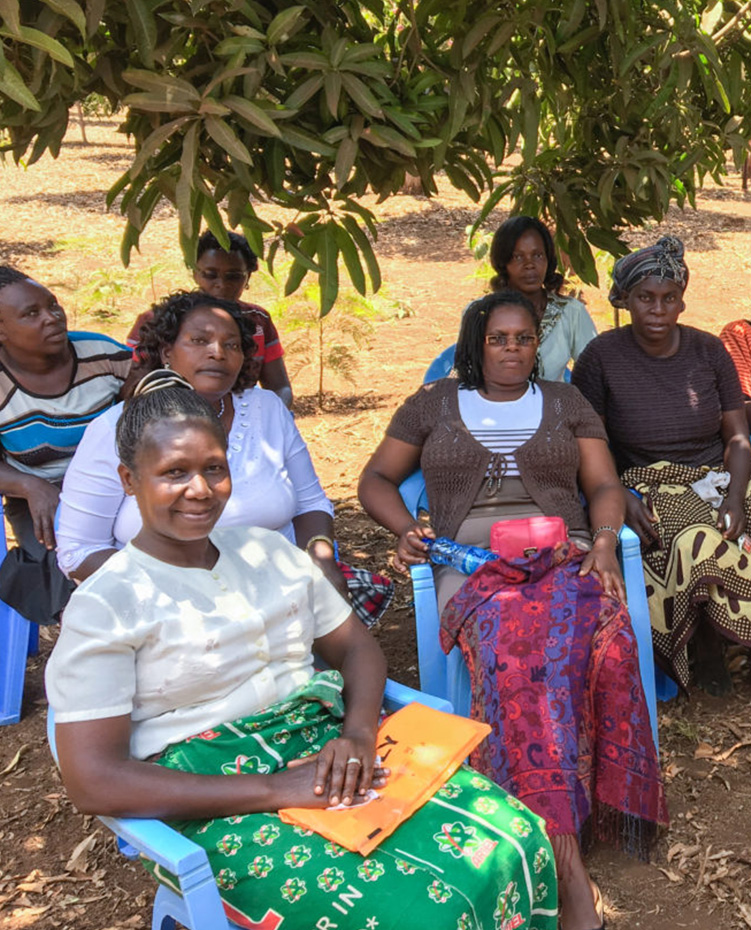
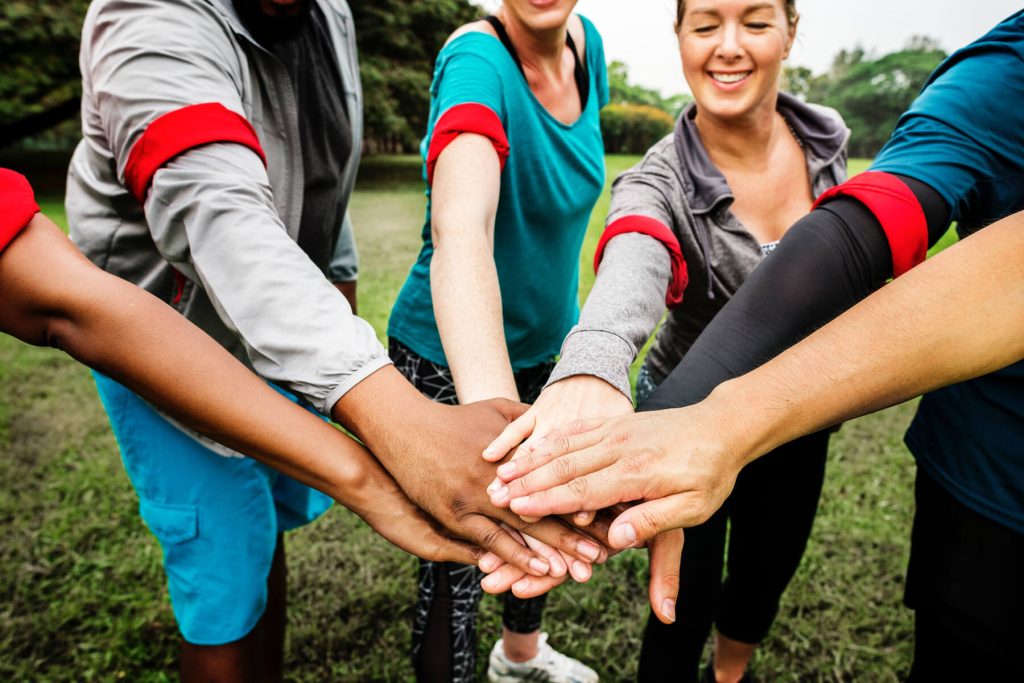
As Protect A Girls Image Organization, we are trying our best to raise awareness on all levels, for instance, there should be a toll-free helpline for victims of gender-based violence.
If you are assaulted by your spouse at night right now, you can’t leave the house because you’re scared you’ll be beaten up even before you get to the police station to report the matter.
You know, femicide has been an issue in Kenya even before the Coronavirus, so these are things that the government and Nonprofit Organizations should just do. Relevant bodies like the judiciary and police should also communicate and share crucial information.
It Is important for authorities to create public awareness of how victims could report cases and receive the necessary assistance.
We need to raise awareness on these issues just like the government is raising awareness on the virus, what measures to take and so on. You know, right now, the situation is difficult.
It is clear from previous epidemics that during health crises, women typically take on additional physical, psychological and time burdens as caregivers. As such, it is critical that all actors involved in efforts to respond to COVID-19 – across all sectors – take GBV into account within their programme planning and implementation.
INCASE YOU MISSED IT:
Donating Food As A Response To Coronavirus/ The Church and Non-profits.
Coronavirus and COVID-19: How We Are Caregiving for the Elderly.
Tips for parenting during the coronavirus (COVID-19) outbreak. {Infographics}
In Kenya, the Protect A Girl Organization is still providing food and supplies to up to 40 different families in Kirinyaga County. The organization is delivering care packages with food and other resources to the community.
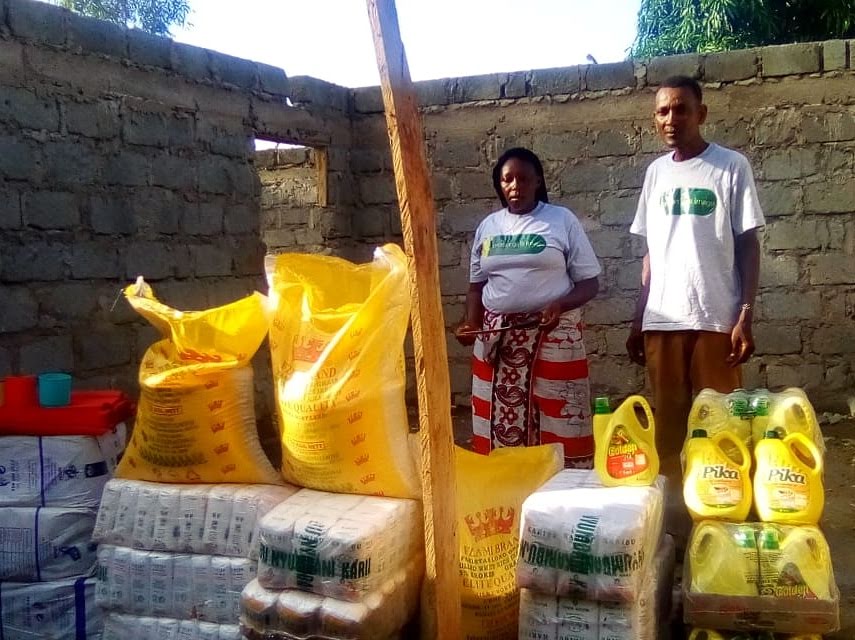
There is a great need for food assistance during this COVID-19 outbreak.
That is why our teams, both here in Kenya and in the USA are doing the best we can to help those in need.
Many local churches we collaborate with are also active in encouraging their members involved in helping others.
One good example is the Agape Apostolic Church of Deliverance in Troy, New York.
Under the Strong Leadership of Pastor David Camp and his wife and Assistant Pastor Paulette Camp, the church came together to start a drive-thru food pantry to help community members impacted by the coronavirus outbreak. Both Pastors have served in ministry at the Church for approximately 28 years.
The church places emphasis on family unity. Among the various forms of outreach, the church reaches out to the poor and needy in the community with “The Bread of Life Community Outreach Program” (food pantry), an Annual Community & Fellowship Fun Day, and the annual Friends & Family Community Backpack and School Supplies Giveaway. Agape Apostolic Church of Deliverance has successfully given away over 2,500 bibles in alms bags to date. The church is rapidly growing and God is a blessing.
The pantry, called “The Bread of Life,” is under the leadership Minister Anthony Lewis.

He coordinated with the church and volunteers to put on Saturday morning’s distribution of bags of food from their pantry.
The church said they’ve served up to 400 families since the coronavirus pandemic began.
“So we usually do it just once a month but you know now, we’re pretty much doing it at least two or three times a week making deliveries,” said Minister Anthony Lewis.
The church’s community outreach program said anyone who’s struggling should not be afraid to reach out.
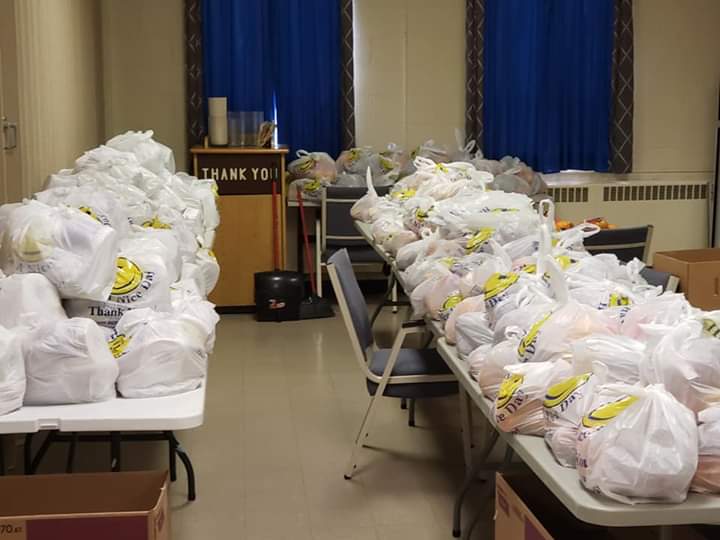

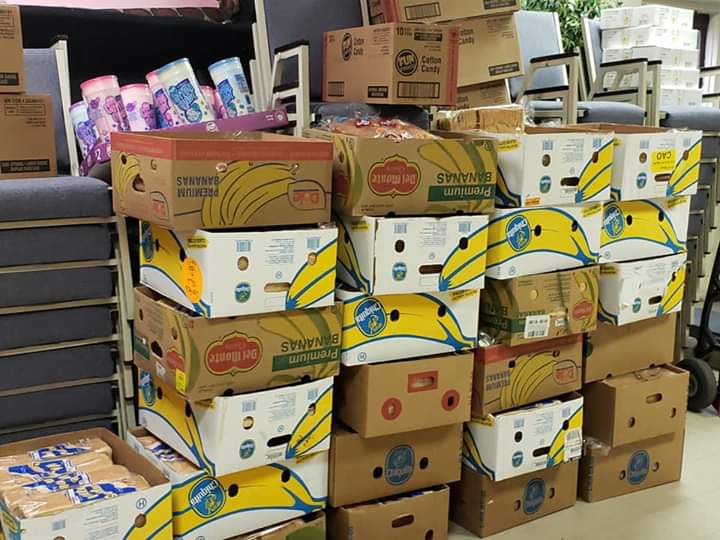
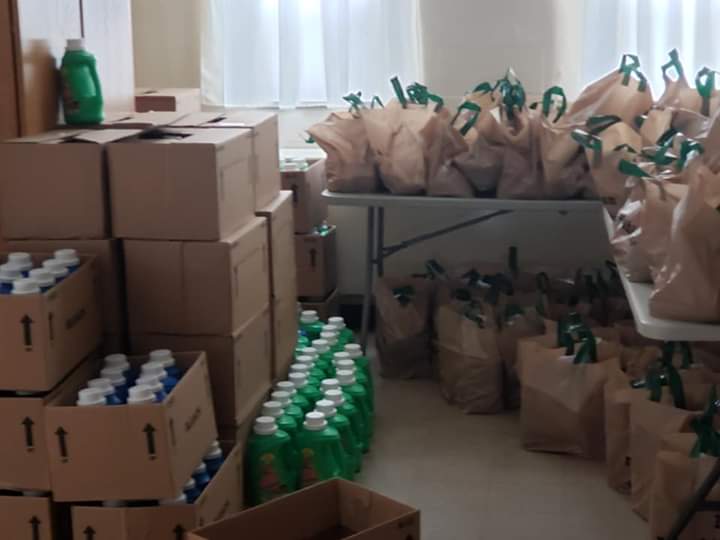
Minister Anthony Lewis quotes “I want to first thank our great Pastor and Assistant Pastor Elder David Camp and Evangelist Paulette Camp for their vision in starting the Agape Bread Of Life Community Outreach Program and how the Saints of Agape and Community Volunteers unselfishly gave their time to come out on such an awesome day to serve the community. We gave out tons of food and supplies to so many families in need. As always God Be the Glory!”
So many people in the US have filed for unemployment assistance in the past five weeks, as the coronavirus pandemic closes businesses and keeps residents mostly indoors. Even before the coronavirus outbreak, 37 million people in the US struggled to find enough to eat according to Feeding America.
They had lines of cars waiting to get food donations from the pantry.
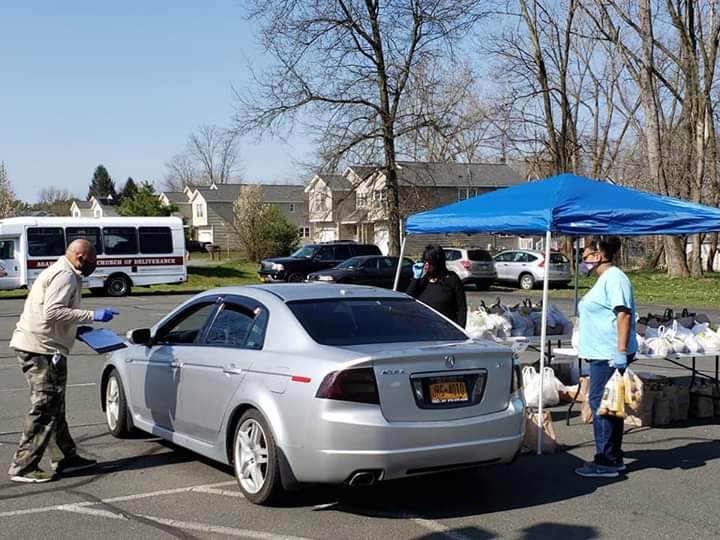
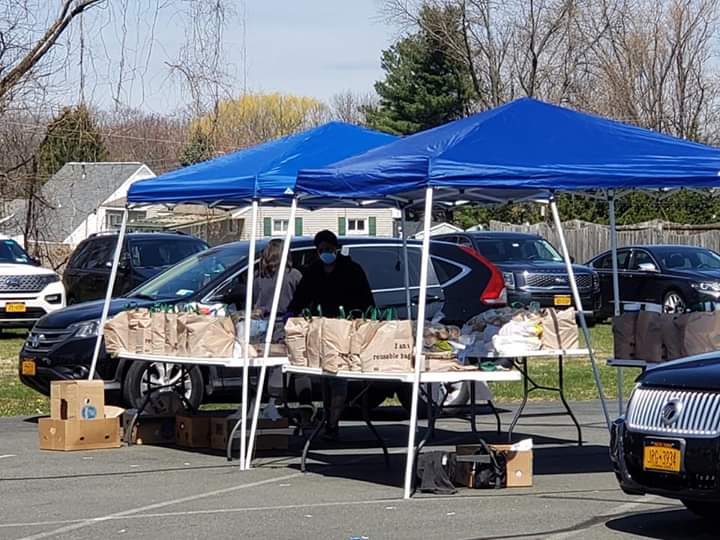
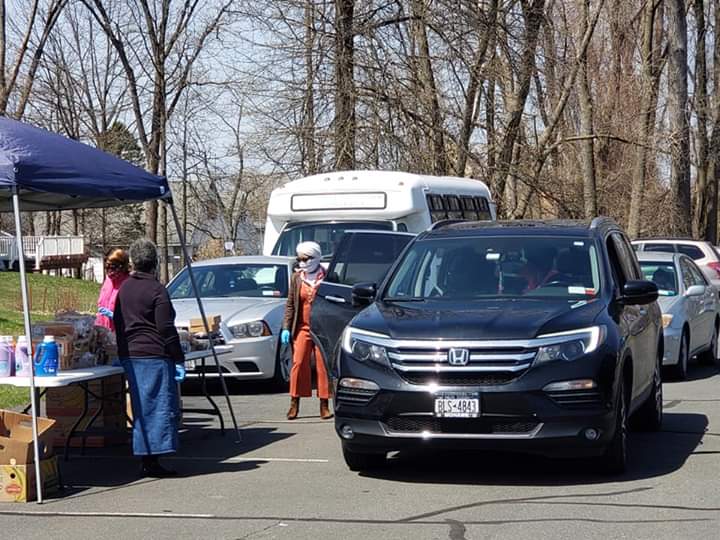
“Don’t be anxious about anything; rather, bring up all of your requests to God in your prayers and petitions, along with giving thanks. Then the peace of God that exceeds all understanding will keep your hearts and minds safe in Christ Jesus.” — Philippians 4:6–7
Protect A Girls Image dedicates our resources, platforms, and will to make the biggest impact on people with the greatest need. This moment is an opportunity to illuminate how we are all affected when some of us lack the protections of a safety net. By focusing on the needs of people most impacted, we can better ensure the health and safety of all communities.
To learn more about the response in your community and how you can help, find us Here.
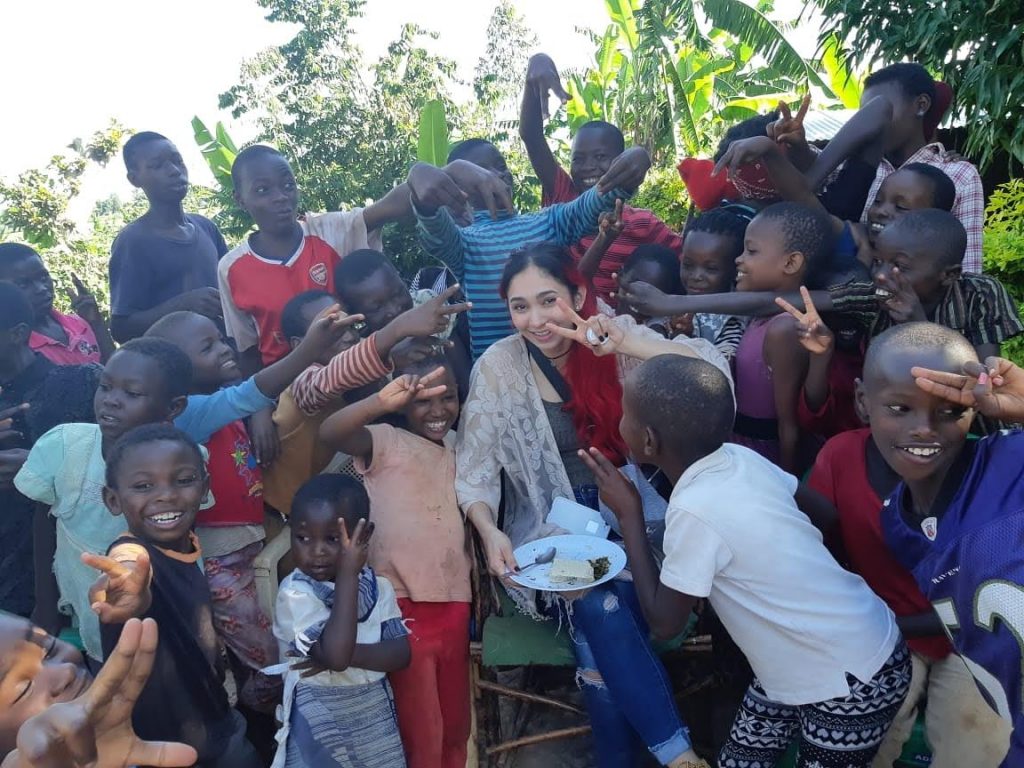
INCASE YOU MISSED IT>>>>>>>>>>>>>>>>>>>>>>>>>>>>>>>>>.
Coronavirus and COVID-19: How We Are Caregiving for the Elderly.
Match Made in Heaven/ How Our Nonprofit partners with the Church.
Tips for parenting during the coronavirus (COVID-19) outbreak. {Infographics}
Protect A Girls’ Image Organization takes pride in taking care of the elderly.
We have members of our organization who collaborate with hospices in Lynden Washington USA to take care of them.
When this Coronavirus Pandemic began, we were really worried because research showed that the elderly are the most vulnerable.
Research is showing that adults 60 and older, especially those with preexisting medical conditions, especially heart disease, lung disease, diabetes, or cancer are more likely to have severe — even deadly — coronavirus infection than other age groups.
While we have no control over certain risk factors such as age and while questions remain unanswered, there is much we can do to prepare and protect ourselves, our families, and our communities.
Our work in the industry is facing unprecedented pressure due to the recent COVID-19 outbreak.
Should the situation continue, we have created a contingency plan to support all the elderly people who are in our care now or may need care in the coming months.
I want to give you a few tips and guidance from some of our experts at PGIO on what you can do to help your loved ones during this time.
First and most important, as a caretaker you should take all the precautions you can to avoid becoming infected yourself. Here are the basics:
One important way to lower the risk of your older family members catching COVID-19 is to limit in-person visits. But this may be tough for older adults who cherish time spent with friends and family members.
Our CEO Margaret Wangui says, “Social distancing doesn’t have to mean isolation or loneliness. We need to keep older adults safe, but also keep in mind that social isolation can have a negative impact on older people’s immunity and mental health.”
She notes that in terms of social contacts, seniors should be encouraged to think beyond their usual circle of friends and family. “Saying hello to the mail carrier or checking in on neighbors close by can add to a sense of connectedness,” Margaret says.
With many houses of worship closing their doors until the pandemic eases, congregants, especially older ones, may feel cut off. “Faith communities are often a big part of older adults’ social lives,” Wangui says. Caregivers might help their loved one access online services and outreach for spiritual solace and support.”
We have really tried to help older residents feel involved, purposeful, and less lonely during the pandemic. This is how we do it:
Arbaje recommends giving homebound older adults a project they can work on.
“Think about going through and organizing old photos and memories together, and enjoy the stories and happy memories they inspire.
It can be a good time for an elder to demonstrate cooking a favorite family recipe or share favorite songs or movies with other people in the household.”
We have really tried to postpone unnecessary doctor visits.
If an older adult in our care is feeling well, we consider helping them postpone elective procedures, annual checkups, and other non-essential doctor visits.
We keep in mind that many older people, especially those living with chronic illness, have important relationships with their caregivers.
To help them stay in touch, we ask their doctors’ offices if they offer telemedicine which enables doctors and patients to communicate over the video, email, or other means rather than face-to-face.
We try as much as possible to involve the older family members in discussions of how they will manage interruptions of routines and what will happen if they (or someone else in your family) becomes sick.
Talking things through ahead of time as a family can reduce stress and help everyone feel more involved and prepared.
We normally pick an emergency contact.
If you’re the main caregiver, designate someone nearby whom you could rely on to care for your elderly family member if you yourself become ill.
We keep regular medications and other supplies well-stocked.
Given the vulnerability of older individuals and those with chronic conditions, we recommend that you should have access to several weeks of medications and supplies in case they need to stay home.
Monitor food and other medical supplies needed and create a plan in the event that such resources become depleted.
For families, know what medications your loved one is taking and see if you can help them have extra to hand.
We have gathered one to three months of medications, and at least two weeks’ worth of food, over-the-counter remedies, pet supplies, and other essentials.
It is also good to find out which delivery services are available in your area.
If you or your loved one learn that you might have been exposed to someone diagnosed with COVID-19 or if anyone in your household develops symptoms such as cough, fever, or shortness of breath, call your family doctor, nurse helpline, or urgent care facility.
For a medical emergency such as severe shortness of breath or high fever, please call 719 or text *719# which is a toll-free number provided by the Government of Kenya.
You can also call the following County Hotline numbers 0800721316 (tollfree) / 0732353535.
Some of our households are multigenerational, with different people at different levels of risk residing under one roof.
Households, therefore, will need to consider the risks of all its members.
One important consideration is that many older adults live in homes where other members, such as children, may have frequent colds.
Your family institute can change now by not sharing personal items like food, water bottles, and utensils.
If possible, choose a room in your home that can be used to separate sick household members from those who are healthy. If possible, also choose a bathroom for the sick person to use.
The situation with COVID-19 is changing rapidly.
For example, in some areas, China has moved from in-home quarantine and isolation to dedicated facilities for suspect cases and others for confirmed cases.
That means everyone should find and regularly check a trusted information source such as the WHO’s dedicated website or their national public health agency.
Protect A Girls’ Image Organization continues to work with public health authorities to identify specific coronavirus related issues relevant to the over 50s.
Meantime, in this setting of well-founded concern, occasionally unfounded fears and rapidly evolving dynamics, it’s always important to remember your health basics for a strong mind and body: maintain a healthy lifestyle, which includes engaging in moderate exercise, keeping a healthy diet and getting regular sleep.
Household clusters of COVID-19 infections demonstrate the virus can spread more easily among people living under the same roof.
However, with planning, and incorporating additional steps as more information emerges, together we can try to minimize the impact of the COVID-19.
I hope all these tips help you when it comes to taking care of your elderly loved ones. If you have any questions or contributions, feel free to share in the comments below.
We have more amazing content here:
How To Talk to Children and Help Them Cope With Changes Resulting From COVID-19.
Match Made In Heaven- How Our Nonprofit Partners With A Church.
Across the world, due to the spread of coronavirus disease (COVID-19), children are affected by physical distancing, quarantines and nationwide school closures.
I am sure most of your children and youth may be feeling more isolated, anxious, bored and uncertain.
They may feel fear, and grief, over the impact of the virus on their families.
I have really been working hard to find content that will help open the world of isolation.
Watch out for resources and ideas to support parents and projects that will engage children in understanding the coronavirus, the challenges it brings to their world and what can be done to protect them.
I have also done a previous blog about how you can spark a meaningful conversation about coronavirus with your children.
To help parents interact constructively with their children during this time of confinement, I have shared below very simple but constructive tips you can use while parenting during this period.
I have these six one-page tips that I outsourced from WHO for parents.
They cover the following:
RELATED CONTENT: Your Daughter Does Not Owe Anyone a Hug This Easter Holiday, Not Even Grandpa.






I hope this information helps in one way or another in helping your little ones cope during this confusing period. Feel free to click on the Links on the Infographics to learn more.
Have an amazing weekend!!
INCASE YOU MISSED IT:
Coronavirus- How to Manage Your Mental Health During Self-Isolation.
10 Tips on How Parents Can Help Children Who Have Experienced Trauma.
As coronavirus continues to spread all over the world, governments have implemented lockdowns and curfews as a measure and that means that most of the travel has been restricted.
The new measures have also seen pubs, restaurants, and theatres close, while people have been asked to work from home where possible.
The COVID-19 pandemic has caused global stress, fear of the disease and the unknown future. Extreme stress can really affect your mental health and cause depression and anxiety.
I know you are not used to staying indoors for long periods of time and being isolated from your social support structures. This is why you are feeling worried and low most of the time.
It is recommended by psychology experts that you should try and maintain a normal routine when it comes to sleep, nutrition, and exercise especially if you have an existing mental health condition.
Again, I know it is not easy!
The World Health Organization (WHO) released a mental health guide for people who are self-isolating saying: “This time of crisis is generating stress in the population.”
So what should you do if your mental health is suffering during self-isolation; are there ways to ensure you safeguard your emotional and mental wellbeing during a potentially extended period of being alone?
Yes! Read till the end to learn how you can manage your mental health during this crisis period.
I believe that one of the main problems with self-isolation is that we start to miss “micro-lifts” that we normally have peppered throughout our day without even necessarily realizing.
Micro-lifts are the small little things throughout your day that helped lift your spirits up even without realizing it.
It could have been your favorite coffee shop, listening to preaching or a podcast on your way to work or saying hi to the funny gateman.
When you’re alone at home that doesn’t happen – and the cumulative effect of that is massive, especially around the two-week mark.
So try and create micro-lifts at home. Try things that generate a sense of achievement.
It could be trying out exercises, reading a book, joining an online group you share the same values with or just face timing someone.
You may be limited in the amount of exercise you can do if you’re stuck inside self-isolating or working from home, but it’s still important to get your body moving.
Moving can really help bust through those stress levels and give an instant shot of happiness.
With months of the coronavirus pandemic ahead, it is important to keep exercising. Did you know that regular exercise produces chemicals, such as dopamine and serotonin, which are as effective as antidepressant medication or psychotherapy for treating milder depression?
It is important to create a daily exercise routine at home. It does not have to be complicated.
A few stars jump and skipping rope will do the trick.
To make it fun, look out for free Zumba dance routines on YouTube.
If you struggle with exercise, start small, maybe 10 minutes a day and then add a few minutes daily.
Anxiety is likely to increase during the current crisis, but a well-nourished body is better at handling stress.
Traditional Mediterranean foods are sometimes referred to as the ‘anti-depression diet.
It has anti-oxidant and anti-inflammatory properties. Such foods include whole grains, vegetables (particularly green leaves), fruit, berries, nuts (including almonds), seeds and olive oil.
They are really good for your mental health.
When you’re at home it can be tempting to just sit on the sofa without moving, eating unbalanced meals and snacking all day as a way to entertain yourself.
Please do your best to eat well.
If you haven’t got people who can bring food to you then see if you can sign up for home deliveries from your local supermarket.
Have a look to see if there are any community support groups in your local area that can provide support with shopping.
Protect A Girls Image is Helping Families in rural Kenya with food.
Do you find yourself spending all day in your pajamas or remembering at 3 pm that you haven’t brushed your teeth because you knew you wouldn’t be seeing anyone?
Although in the short term it can feel nice to be lazy, in the long term this isn’t going to be good for your mental wellbeing.
I am seeing a lot of people who are self-isolating are losing their optimism for the future, they are using time for self-reflecting and picking apart everything that is wrong with their life: their job, their relationship, their friendships.
Like I explained above, try to maintain as much of a routine as you can.
This is how you could do it:
If you live with other people, it may help to do the following:
Sitting in front of a screen all day – whether for work or pleasure – is not the best way to spend long periods of time.
Especially because the blue light from devices, like smartphones, can be disruptive to your sleep and overall wellbeing.
Instead of watching Tv, I suggest the following:
Just because you’re self-isolating, doesn’t mean you have to cut yourself off altogether.
If you feel that you’re beginning to struggle, take some time to call a friend or family member.
Talk about how you’re feeling. I have a few tips for you:
Ninety percent of depressed people struggle with sleep, which is likely to increase with fears over the coronavirus.
Good quality sleep is a form of overnight therapy and increases the chance of handling strong emotions effectively.
Try to wake up and go to bed at the same time every day.
Achieving eight hours of sleep, taking a hot bath, setting the bedroom temperature to 18°C and having no screen time two hours before bedtime will also help.
If you are finding the constant 24/7 coverage of coronavirus is impacting your mental health, particularly on social media, then you can opt-out.
The World Health Organisation says: “A near-constant stream of news reports about an outbreak can cause anyone to feel anxious or distressed.
Please try and avoid listening to or following rumors that make you feel uncomfortable.
Be careful about the balance of watching important news and the news that could cause you to feel depressed and disrupt your mental health.
Have breaks from social media and mute triggering keywords and accounts.
Social media could help you stay in touch with people, but might also make you feel anxious including if people are sharing news stories or posting about their worries.
Consider taking a break or limiting how you use social media.
You might decide to view particular groups or pages but not scroll through timelines or newsfeeds.
The most dangerous thing for your mental health is having too much time to think about your life critically.
When self-isolating you’ve got a lot of time to think and it’s very common to experience massive life dissatisfaction as a result.
You get into a constant flow of critiquing your life and yourself, and you really need to avoid those negative cognitive spirals.
It will help to try and see this as a different period of time in your life, and not necessarily a bad one, even if you didn’t choose it.
It will mean a different rhythm of life, a chance to be in touch with others in different ways than usual.
While watching Netflix may seem like a great way to relax and rewind, we should also remember to watch something that won’t make our mental health even worse.
Bust out those box sets, get the duvet out and hunker down.
But just as TV can boost our mood, equally it can make us feel crappy too.
So be careful with what you watch, maybe leave the dark apocalyptic thrillers for another time and choose something more joyful, uplifting, or funny instead.